Learn about the different components of watch faces including types of watch dials, hands, indices, sub dials, bezels, and more.
A watch’s first and primary goal is to tell the time, even though a smartwatch might disagree with that statement. The dial or face of the watch is the information delivery system, it lets you know what time it is as well as any complication or other information it can deliver.
The standard minute and hour hands and often a second hand is recognized globally as the system by which we tell time. How that information is organized, indicated, and decorated very greatly from watch to watch. To understand all the variations and options available to watch makers we first need to break the dial down into its parts to understand what make a watch face a time telling instrument.
The main components of a watch face are:
The Dial – This is the material, color, and finish/texture of the surface of the dial.
The Hands – The markers that indicate what time it is.
The Indices – These are the markings that represent the time.
Sub Dials – Many watches include additional or separate information on set-in or set apart sub dials. This can include digital readouts as well as analog dials or both.
The Bezel – Bezels are the area around the dial and often have additional markings and information related to the dial. This is especially true of dive watches which have a rotating bezel with minute counters.
The Crown – The crown along with any buttons or other input means are how one sets and interacts with the information on the dial.
Watch Dials
The simple dial can be broken further down into a few basic categories:
Plan – Usually a flat color that can be shiny or mat in finish. The most common type of plan dial is the plan, painted/printed or enameled metal disk. The substrate is often stainless steel or some other type of common metal such as brass or bronze. Of course, you can have dials with precious metals, these are typically gilded, or electro plated.
Textured/Patterned – Textured dials have a long history in watch making and can have any type of pattern. Some of the most recognized include:
Guilloche – is a wave like pattern on the dial. Often done with a brushed or mat surface. Originally Guilloche dials where hand-engraved but are mostly machine made these days.
Linen – looks very much like the cloth but is engraved or embossed in a metal surface.
Marquetry – is a dial art form that takes a material such as mother of pearl and arranges small pieces into patterns. I think of this technique like a parquet floor for watch dials.
Tapisserie – like guilloche, tapisserie is a pattern that is engraved on the surface of the dial, but rather than creating a wavy pattern it is a pattern of small squares. The Audemars Piguet Royal Oak is well known for this style of dial.
Teaked – dials reference the vertical strips of a ships teak deck. It consists of simple engraved or painted/printed vertical lines, usually in a subtle color pattern.
Skeletonized – Dials with skeleton features are simply dials that have holes that show the machinery of the watch below. The simplest form is the “open heart” that shows the escapement beating. The most dramatic examples incorporate the mechanisms of the watch in the design of the dial with all the components exposed. Another good example is the Tourbillion complication that is almost always exposed on the dial of the watch.
Unique – Unique dials are often made from a precious material or are some form of hand-crafted art. A great example is the Meteorite dial which is made from a slice of meteorite. There are also dials made from stone, wood, mother of pearl, brass/bronze, cloisonné or anything else the watch maker can dream up.
Check out some examples from Crown and Caliber and Uplarn, here and here.
Watch Hands
The hands of a watch are critically important, as they are what indicate the passing of time. They need to be exactly right so you can see the time easily and accurately. There are basically 12 types of hand styles plus the one-of-a-kind’s that show up every now and then. Even though I have illustrated 12 styles of watches each have variations and exceptions. Another style that I have not listed is the Fleur De Lys style of hand which is basically a Baton style hand with a Fleur De Lys pattern in it, I have also seen this style of hand with other designs in the hands, including a brands logo or other shapes to set the hands apart. An example of one-off hands includes the “snowflake” style from Tudor Black Bay Line. Below you can see examples of some of the types of watch hands as well as here.
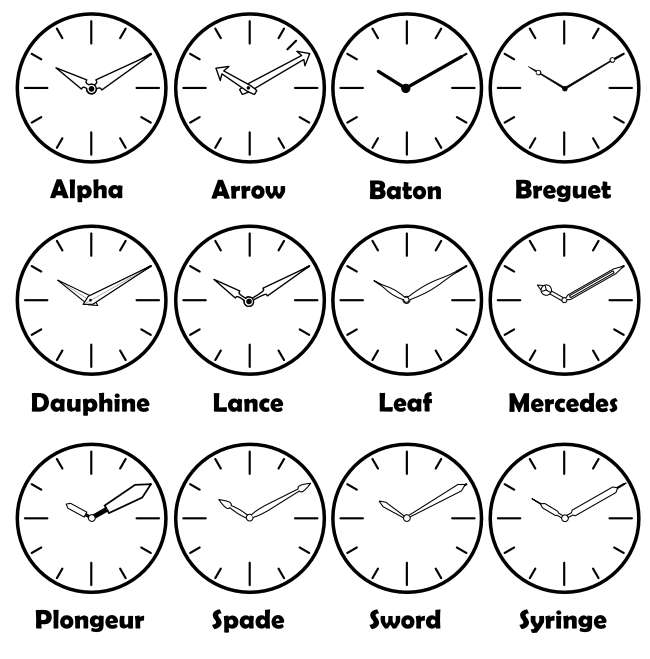
My Visitor watch is a great example of one-off watch hands. In Visitors case it was inspired by fountain pen nibs. Check out my review of the Visitor, here.
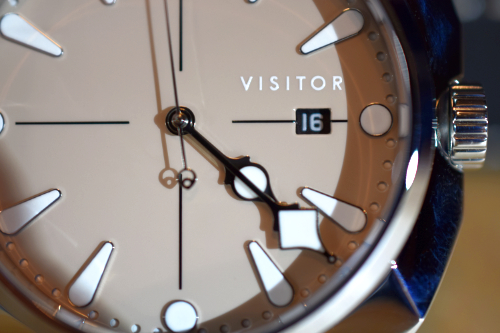
Indices
Indices or the markings on the dial come in several different styles. The most common styles often relate to what type of watch it is. For example, stick markers for the hours are very prevalent on dress watches, where dive watches almost always have dots for the hours. Below is a selection of indices types which can and often are arranged in any number of variations.
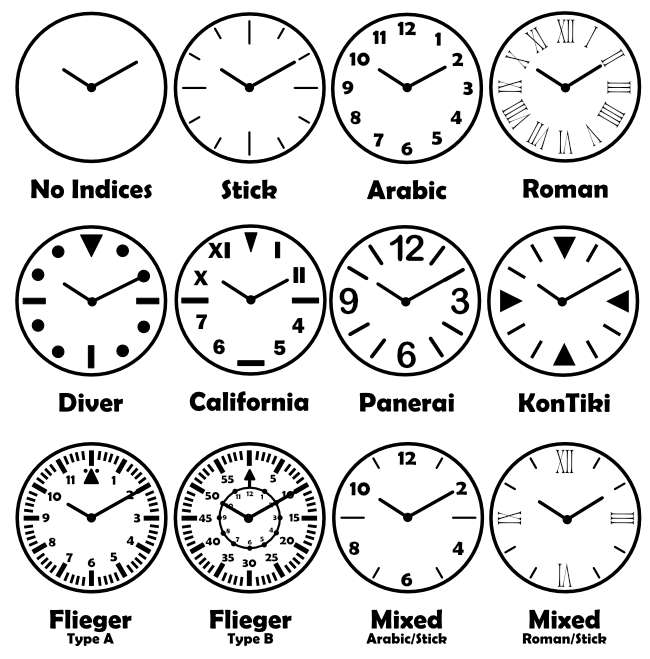
How the markings get on the dial typically come in one of four forms plus variations or blends of each type. Printing the numbers or markings on the dial is the most common type of watch dial, with applied (usually glued on) indices being the upgrade for printed ones. Another type of indices come from sandwich dials, where there are two disks stuck together with holes in the top one and usually a luminous paint on the bottom one that shines through to create the markings. The final type are 3D dials that are either assembled or formed from a material or materials to create the indices. One of the best examples of these types of dials is the Hublot Ferrari series.
Sub Dials
One of the most prevalent ways to deliver additional information on a watch dial is with subsidiary (or sub) dial. This is especially true for chronograph watches. Another dial style that is dependent on sub-dials is the regulator style of dial, where each component of the time (hours, minutes, and seconds) are represented in their own dial. Some of the standard sub-dial layouts are represented below but are by no means everything that is out there.
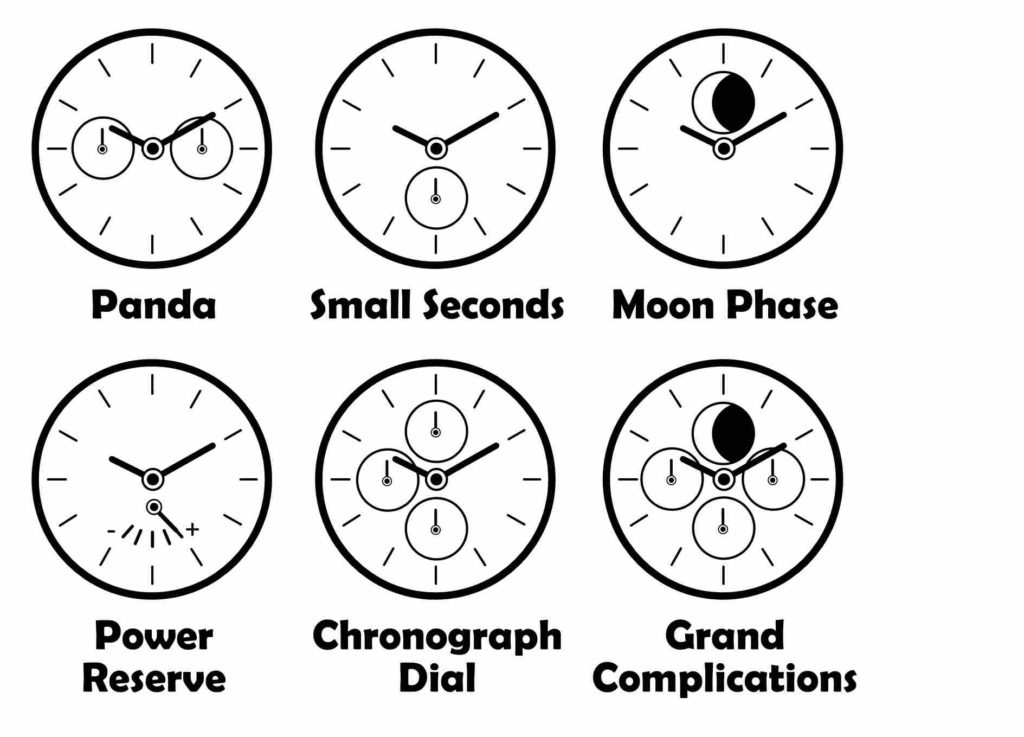
The Bezel
The bezel of a watch is simply the rim of the watch cover. Bezels come in basically two styles, plain and informational. The plain bezel is typically a metal ring that can be part of the case and often protects the crystal, sometimes these can be jeweled or decorated. Informational bezels come in a variety of styles with the diving watch bezel or count-up bezel being one of the most prevalent. Here is a quick list.
Count-Up – a metal ring with 0-60 minute markers that can rotate typically one direction to mark elapsed time. Most often seen on dive watches.
Count Down – like the count-up bezel except it marked 60-0 and indicates time left to 0.
Tachymeter – mostly used in racing inspired watches the tachymeter is a fixed bezel that measures speed in consideration to time and distance traveled. This type of bezel is most commonly used in conjunction with a chronometer.
Telemeter – is a less common bezel style that is used to measure distance from an observer and an object or event. An example would be the distance a lighting strike is from the observer.
GMT/World Timer – is a bezel style use to track a second time zone for when you are traveling.
Compass bezel – is a basic orienteering bezel that is marked with the cardinal directions and often rotates in relationship to you position to the sun or some other natural marker.
Pulsometer – is a bezel designed to help doctors and nurses to measure a patents pulse.
Slide Rule – bezels are one of the most complicated bezel styles and are designed to do mathematical calculations just like a regular slide rule. They bezel includes an inner fixed ring and an outer movable ring used to make the calculations with.
For more bezel styles with examples check out WatchRankers excellent post, here.
The Crown
Crowns are how you set the watch and can include buttons (called pushers), touch sensors/screens and even rotating bezels that move through menus on a smart watch. On manual and automatic watches, the most common crowns are simple knobs that when pulled out engage the hands and date complications. Added features of the standard crown include the screw down type mostly found on dive watches to increase water resistance. Some watches include covers for the crowns to increase the water resistance. Watch crowns are typically mounted on the inside or right side of a watch that is designed to be worn on the left hand. Destro (Italian for “right”) is when the crown and pushers are mounted on the left side of the watch and is intended to be worn on the right hand. One of the more interesting outliers regarding crowns is Pita Barcelona’s crownless Oceana line, that uses a patented rotating case back to set the time. The Oceana is water resistant to 5000 meters making it a profoundly serious dive watch.
Digital Dials
With the advent of the Hamilton Pulsar P1 and the LCD screen, watches broke with tradition and could have completely new types of dials. The smart watch has taken this trend and taken it to next level with dials that are one large LCD screen that can change their look with a touch of a button.
Digital dials can be simple cheap LCD (liquid crystal display) screens to full on OLED (organic light emitting diode) screens that basically are mini smartphone screens. LCD screen are most often found at the bottom of the market and just show the time and date. With smartwatch’s the screen be changed to whatever taste you have and can show almost any information that your smartphone can feed it. Some of the best examples of digital dials would be Casio’s F91W-1 Casual Sport Watch and Apples Series 5 Smartwatch.
Outliers
Sundials or one-handed watches as well as 24-hour dial watches break most of the rule of watch dial layouts. The intent of a single-handed watch is to simplify the telling of time by eliminating all the clutter, with the single hand telling both hour and minute as it rotates around a 12-hour dial.
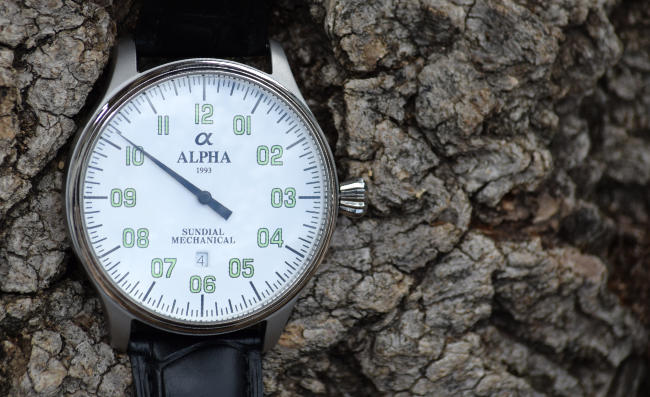
Pictured above is an example from Alpha, but the brand MeisterSInger has completely embraced the single-handed watch idea with their whole line being single-handed watches. With 24-hour dialed watches the watch hands only rotate around the dial once ever 24 hours and they are often indicated with military time markings, as in the Lum-Tec Combat B37 pictured below. Another brand that has totally embraced the 24-hour dial is Glycine with their Airman line, I particularly like the bronze version the GL0166, check it out here.
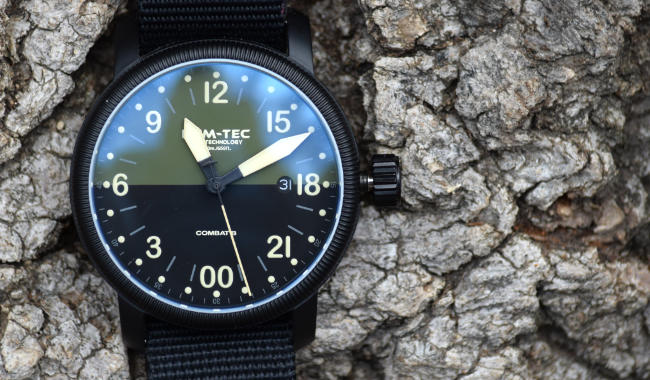
There are other types of dial styles with endless variations on each theme. It seems to me that someone is always looking to invent or re-invent the next best idea in watch design. This is probably one of the best aspects of watch collecting, the ever evolving face of watch style and design.

